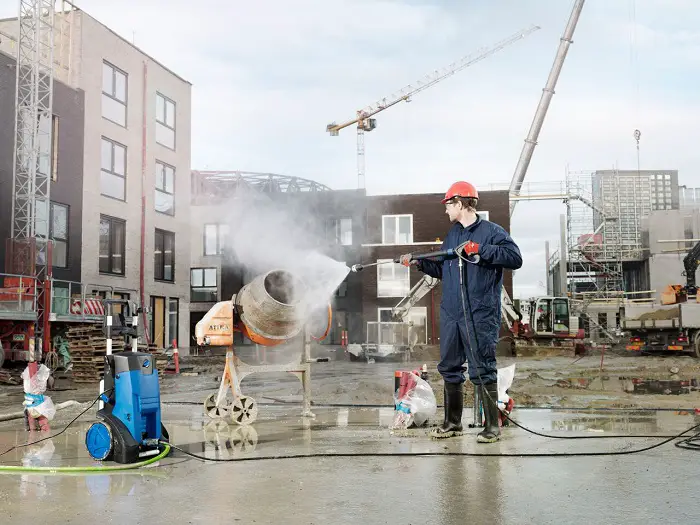The cleaning demands of the building and construction industry are heavy duty. Rubble, dust, paint, grease, oil and, sometimes, hazardous materials like asbestos are part and parcel of the business.
“It’s not just the site that presents cleaning challenges but also the equipment,” notes Gavin Herold, General Manager of Africa and the Middle East for Nilfisk, who says a new wave of specialized technology is available which boosts productivity, reduces costs and improves worker safety.
“Irrespective of whether it’s a major construction company or a small craft firm, the better the design of the cleaning equipment the lower the overall lifecycle costs. True cost savings are achieved through efficiency of operation, reliability and ease of maintenance, all of which are entirely dependent upon the quality of the product’s design.”
The primary cleaning requirements of building and construction companies are in four basic categories.
Pressure cleaning for tools and other equipment.
Properly cleaning building equipment boosts productivity but the dirt is often intense and ingrained. Quick and thorough cleaning demands robust and stable equipment, preferably with wide wheels for uneven environments, and a powerful combination of high water flow up to 2500 l/h and high pressure levels up to 180 bar.
On bigger sites it’s an advantage if two people can use the equipment at the same time as with the Nilfisk MC 8P.
Noise reduction and good ergonomics matter for worker health and for ease of use.
Details are important: like pump oil sight, ceramic pistons for longer life and safety brakes.
Dust pick up and extraction
There have been marked improvements in the design of specialized dust extractors including: increased air velocity in hoses, nozzles and tool connectors; automatic filter cleaning systems; reliable filtration efficiency of fine dust particles at a minimum of 99.9%; no dust emission from exhaust air or power tools during the filter cleaning cycle; the same filter used for wet and dry pick-up.
The new ranges are also far easier to transport and have much more flexibility in usage with multiple options on filters or dust bags.
Dust class L, M & H safety vacuums are available for different levels of hazardous material extraction. Class H machines allow for health-endangering dusts like asbestos to be extracted safely and are especially important for roofers and painters.
Industrial sweepers
There are now different models for every kind of sweeping: from small and compact to walk-behinds destined for more intense jobs. At the high-end sweepers are capable of covering up to 16,000 m² per hour with strong, lightweight polyethylene covers and bumpers over a steel chassis providing automobile industry quality protection. For indoor use, they can be equipped with battery power or LPG.
Machine manoeuvrability has improved with power steering, and smarter controls simplify operations and reduce operator errors. A free floating main broom and fine tuning knob adjustment increase productivity.
Control of airborne dust particles is critical for health and to ensure that the job can be done in a single pass. The Nilfisk SR1601 has a trademarked DustGuard system which delivers exceptional control of airborne particles.
One other area of considerable improvement is fast and easy access to all parts of the machinery to facilitate servicing.
Vacuuming for final cleaning
A good industrial vacuum collects dust and debris permanently, making the environment fully clean and dust-free for site handover.
Nilfisk models are equipped with the self-cleaning InfiniClean filter which allows the operator to complete the entire cleaning process without needing to stop and clean the filter.
Press Contacts:
Emma Corder
Nilfisk (Pty) Ltd
T +27 21 691 0080
Samantha Claase
Ogilvy Public Relations
T +27 21 467 1346

